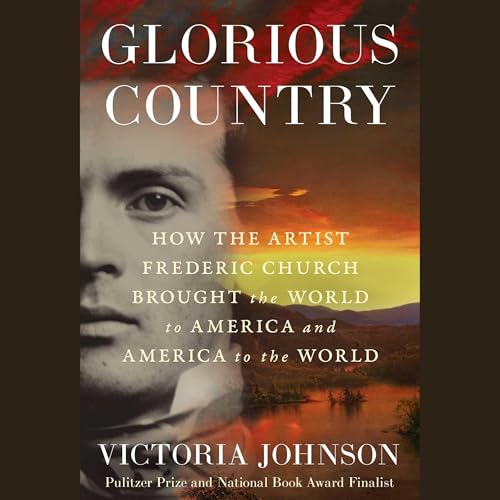
Glorious Country
How the Artist Frederic Church Brought the World to America and America to the World
カートのアイテムが多すぎます
ご購入は五十タイトルがカートに入っている場合のみです。
カートに追加できませんでした。
しばらく経ってから再度お試しください。
ウィッシュリストに追加できませんでした。
しばらく経ってから再度お試しください。
ほしい物リストの削除に失敗しました。
しばらく経ってから再度お試しください。
ポッドキャストのフォローに失敗しました
ポッドキャストのフォロー解除に失敗しました
聴き放題対象外タイトルです。プレミアム会員登録で、非会員価格の30%OFFで予約注文できます。聴けるのは配信日からとなります。
オーディオブック・ポッドキャスト・オリジナル作品など数十万以上の対象作品が聴き放題。
オーディオブックをお得な会員価格で購入できます。
30日間の無料体験後は月額¥1500で自動更新します。いつでも退会できます。
¥2,700で今すぐ予約注文する
-
ナレーター:
-
著者:
-
Victoria Johnson
このコンテンツについて
“They came to see the world.”
New York, spring 1859. Outside Frederic Church’s Tenth Street studio, men and women amassed by the thousands hoping for a glimpse of his magnificent Heart of the Andes: a painting whose sublime, ‘near supernatural’ rendering of the vast Andean landscape encountered on the artist’s recent travels introduced thousands of Americans to the fierce, majestic beauty of the far-flung wildernesses of the globe.
Frederic Church brought the world to America, and America into the world. Cementing the United States as a cultural and artistic force a full century before America’s Abstract Impressionists rose to prominence, Church’s bold paintings composed odes in color, shadow, and light to natural places near and far: the lush jungles of South America and immense icebergs of Newfoundland where he journeyed as a young man; the Syrian deserts and ancient, ruined cities where he and his wife traveled following the devastating loss of their two young children; the verdant, luminous valley around the Hudson where Church first studied painting and where he returned and established his estate, Olana, whose landscape itself became a work of art. Deeply influenced by the work of Alexander von Humboldt, Church conjured a vision of the natural world as a place of communion with creation.
Church charted, across the latter half of the 19th century, a career that both inhabited and gave shape to the artistic, cultural, and political crosscurrents of his day. Through a close examination of Church's letters, sketches, paintings, and diaries, and traveling in Church's footsteps to Egypt, the Andes, Petra, Jamaica, and Jerusalem, Johnson traces the path not only of one man’s life, but of a country swept up in an era of vast and vertiginous change. Church worked and lived in New York in the city’s formative years. He was a founder of its first great museum, the Met, and in paintings, not in words, he conveyed his passion for the exquisite natural beauty of the United States, but also for a Union free of slavery. He gave Americans visions of the majesty of their own new country and of the wonders of worlds only to be seen in paintings by this astonishing adventurer and artist. Church was a master artist and innovator, turning landscape painting into a portrait of a nation, and in the process, putting American art on the map of the world. Glorious Country is a book, Johnson writes, “about how we see and what we save.”
まだレビューはありません


